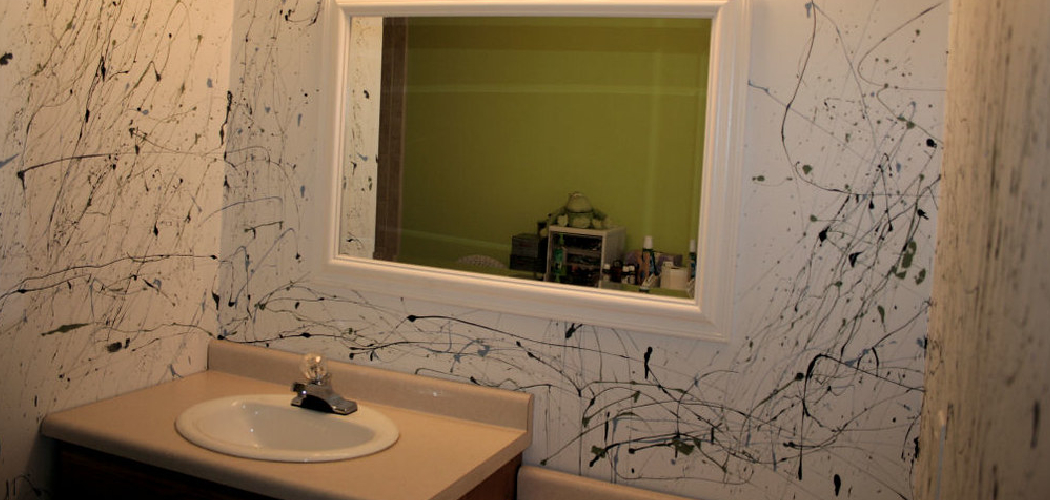Discovering paint stains in your sink can transform from a minor nuisance to a significant challenge, affecting both the beauty and functionality of one of the most utilized areas in your home or workspace. Whether it’s from a hasty clean-up after a DIY project or an accidental spill, paint can leave behind stubborn stains that seem resistant to casual cleaning efforts. This common predicament underscores the need for a focused guide on how to get paint out of sinks efficiently.

The visual appeal of your sink is immediately compromised with the presence of paint splotches, shifting from a clean, welcoming space to one that appears neglected and unkempt. Furthermore, certain types of paint can damage the sink’s surface over time if not addressed promptly.
Recognizing the importance of swift and effective removal techniques is crucial to restoring your sink’s appearance and maintaining its cleanliness. This guide endeavors to arm you with the knowledge and strategies needed to tackle this issue head-on, ensuring that your sink remains a pristine and functional component of your household.
Types of Paint Stains
Understanding the types of paint stains you may find in your sink is a critical first step in addressing this concern effectively. Generally, the most common paint stains encountered are water-based and oil-based paints. Water-based paints, inclusive of latex and acrylics, are known for their ease of clean-up, often requiring just soap and water.
They tend to dry quickly and do not adhere as stubbornly to surfaces as their oil-based counterparts. On the other hand, oil-based paints, which include enamels and some varnishes, are characterized by their durability and resistance to water, making them significantly more challenging to remove once they have dried.
The composition and properties of these paints play a pivotal role in the stain-removal process. Water-based paints are polymer emulsions that dissolve in water, simplifying the cleaning process. Conversely, oil-based paints consist of a drying oil, a resin, and a thinner or solvent; these components require solvents, such as mineral spirits, for dilution and removal.
Identifying the type of paint stain is paramount for selecting the most effective cleaning strategy. The choice of removal method hinges on the paint’s base; using the wrong approach can not only prove ineffective but might also cause further damage to your sink’s surface. For instance, employing harsh chemicals or abrasive tools on water-based paint might scratch or mar the sink unnecessarily, while simply using soap and water on an oil-based stain will likely be futile.
Factors Affecting Stain Removal
Several critical factors influence the process of removing paint stains from sinks, each affecting the strategy and outcome. Understanding these variables can significantly enhance the effectiveness of your stain removal efforts.

A. Discussing Variables Such as Paint Drying Time, Sink Material, and Stain Severity
First, the drying time of the paint plays a substantial role. Fresh, wet paint stains are considerably easier to remove than those that have dried and hardened. The duration for which the paint has settled on the sink surface can turn a simple cleanup into a challenging task. Secondly, the material of the sink itself matters.
Sinks made from stainless steel, porcelain, or ceramics have different tolerances for cleaning agents and methods. For instance, a stainless steel sink may withstand stronger solvents than a delicate porcelain one. Finally, the severity of the stain—whether it’s a few drops or a large spill—determines the extent of effort and time needed for removal.
B. Explaining the Challenges of Removing Paint Stains from Porous and Non-Porous Sink Surfaces
Porous materials, such as certain types of natural stone, can absorb paint, making stains more stubborn. On the other hand, nonporous surfaces like stainless steel allow for easier stain removal but may also be susceptible to scratching if abrasive methods are employed. Understanding the nature of your sink’s surface is crucial in selecting the appropriate cleaning approach.
C. Importance of Testing Removal Methods in Inconspicuous Areas to Avoid Damage to Sink Finish
Before applying any cleaning solution or method, it is vital to perform a patch test in an inconspicuous area of the sink. This precautionary step ensures that the chosen removal method does not damage the sink’s finish.
Some cleaning agents and tools may be too harsh for the surface, leading to discoloration, dullness, or scratches, which could be more unsightly than the paint stain itself. This approach of testing helps preserve the integrity and appearance of the sink while facilitating effective stain removal.
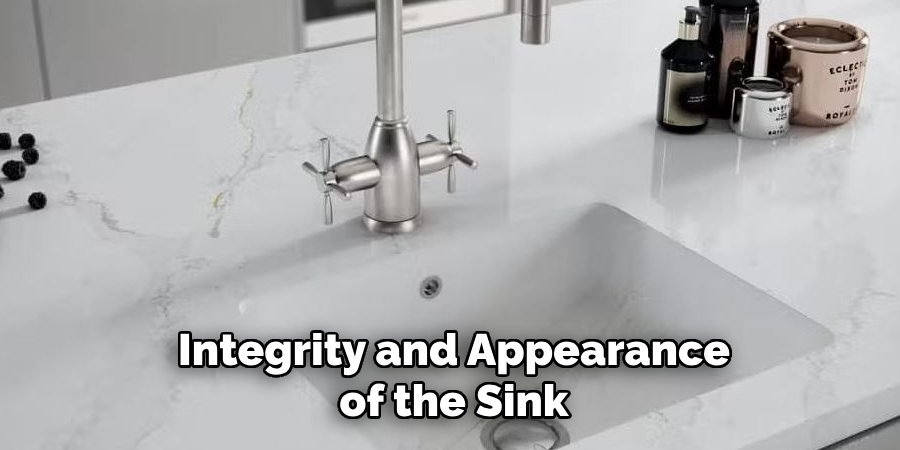
Risks of Improper Removal Techniques
Incorrect paint removal techniques pose significant risks not only to the integrity of your sink but also to your health and the environment. The use of harsh chemicals or abrasive methods can cause irreparable damage to the sink surface and plumbing fixtures.
Aggressive scrubbing or the application of potent solvents may lead to scratches on stainless steel, porcelain, or ceramic sinks and even cause corrosion or discoloration over time. These actions compromise the sink’s aesthetic appeal and functionality.
Furthermore, the improper disposal of paint waste and cleaning solvents constitutes a severe environmental hazard. The paint contains chemicals that can contaminate water sources and soil and harm wildlife when not disposed of correctly. The volatilization of solvents into the atmosphere contributes to air pollution and poses health risks to humans, potentially causing respiratory problems, skin irritation, or other serious conditions upon prolonged exposure.
To mitigate these risks, adopting safe and environmentally responsible practices for paint stain removal is crucial. This includes opting for eco-friendly cleaning solutions, using minimal amounts of solvents, and adhering to proper waste disposal methods. By prioritizing safety and environmental sustainability, you can effectively address paint stains without compromising your well-being or that of the planet.
Preparing the Sink Area
Proper preparation of the sink area is essential for a safe and effective paint stain removal process. This preparation involves several key steps to protect you and your property and ensure that you have everything needed at hand for the task ahead.
A. Clearing Sink of Any Items and Protecting Surrounding Surfaces from Potential Damage
Begin by removing all dishes, tools, and any other items from the sink. This not only provides you with unrestricted access to the stained area but also protects these items from accidental exposure to cleaning agents and solvents. Next, cover the counter and adjacent areas with a protective sheet or old towels to shield them from potential splashes or spills. Especially if you are working with harsh chemicals, this step is crucial to avoid damage to countertops or cabinetry.

B. Ensuring Adequate Ventilation and Ventilating Area to Minimize Exposure to Fumes and Chemicals
Ventilation is critical when dealing with volatile organic compounds (VOCs) present in many paint removers and cleaning solutions. Open windows and doors to ensure a steady flow of fresh air through the workspace. If possible, use a fan to direct the flow of air toward the outdoors, which helps in minimizing your exposure to harmful fumes.
Adequate ventilation not only creates a safer working environment but also aids in the faster evaporation of solvents, reducing the overall time needed for the paint removal process.
C. Gathering Necessary Supplies and Equipment for Paint Stain Removal Process
Compile all the supplies and equipment you will need before beginning the stain removal. This includes gloves, eye protection, brushes or scrapers, and the cleaning solutions or solvents you plan to use.
Having everything within reach will streamline the process, reducing the risk of damage or injury. Depending on the type of paint and severity of the stain, your chosen removal agents might range from mild dish soap and water for water-based paints to stronger solvents like mineral spirits for oil-based varieties.
How to Get Paint out Of Sink: Water-Based Paint Stain Removal
While water-based paint is easier to clean than oil-based variants, proper techniques are still required to ensure complete removal without damaging the sink surface. Below are steps to effectively remove water-based paint stains.
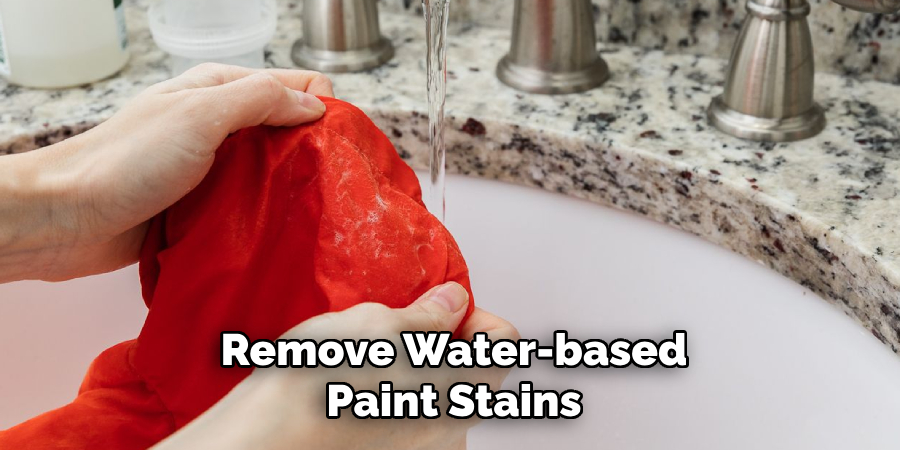
A. Applying Gentle Cleaning Solutions Such as Soap and Water to Water-Based Paint Stains
For water-based paint stains, commence with the simplest and least aggressive method: apply a mixture of mild dish soap and warm water. This solution is often sufficient to loosen or dissolve the paint without harming the sink’s finish. Apply the soapy mixture to the stained area and allow it to sit for several minutes to soften the paint.
B. Using Non-Abrasive Sponges or Soft Cloths to Gently Scrub Stains Away from Sink Surface
After allowing the soapy solution some time to act, use a non-abrasive sponge or a soft cloth to gently scrub the paint stain. Circular motions can be effective in dislodging the paint from the surface without scratching it. For stubborn stains, it may be necessary to repeat the application of the soapy water and scrubbing until the paint lifts away.
C. Rinsing Thoroughly with Clean Water to Remove Residual Paint and Cleaning Solution
Once the paint has been successfully removed, it is essential to rinse the sink thoroughly with clean water. This final rinse helps to wash away any lingering paint particles and residual cleaning solution, ensuring the sink is not only free from stains but also from any potentially harmful substances left behind. After rinsing, dry the sink with a soft towel to prevent water spots and restore its shine.
How to Get Paint out Of Sink: Oil-Based Paint Stain Removal
Oil-based paints pose a more significant challenge due to their durable and resistant nature. However, with the right approach, you can effectively remove these stubborn stains without damage to your sink’s surface.
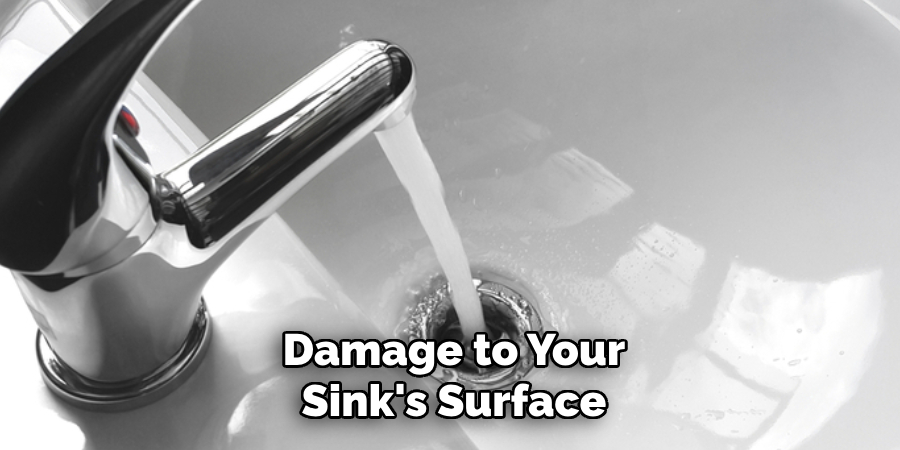
A. Utilizing Solvents Such as Mineral Spirits or Paint Thinner to Break Down Oil-Based Paint Stains
Solvents like mineral spirits or paint thinner are indispensable for oil-based paint stains. These solvents work by breaking down the oil in the paint, making it easier to remove. It’s important to use these chemicals with caution, wear gloves, and ensure good ventilation in the area to avoid inhaling fumes.
B. Applying Solvent to Stain with Clean Cloth and Allowing Dwell Time to Loosen Paint Residue
Begin by dampening a clean cloth with your chosen solvent and gently applying it to the stained area. Do not oversaturate the cloth, as excessive solvent can harm the sink’s surface. Once applied, allow the solvent to dwell on the paint for a few moments. This dwell time is crucial as it gives the solvent ample opportunity to penetrate and loosen the paint residue, facilitating easier removal.
C. Using a Soft Brush or Toothbrush to Gently Scrub the Stain Away, Rinse Thoroughly After Removal
After allowing the solvent to work on the paint stain, gently scrub the area with a soft brush or an old toothbrush. The bristles are effective in reaching the paint within the texture of the sink’s surface without causing scratches.
Scrub in a circular motion, applying enough pressure to remove the paint but being careful not to damage the sink. Following the scrubbing, it is important to rinse the area thoroughly with clean water. Removing all traces of solvent and loosened paint ensures no residue is left behind, which could harm the surface or pose health risks. Finish by drying the sink with a soft towel to prevent water spots and maintain its appearance.

Using these methods, oil-based paint stains can be removed safely and effectively, preserving the beauty and integrity of your sink.
Stubborn Stain Removal Techniques
For the most resilient paint stains, traditional removal techniques may not suffice, necessitating the exploration of additional methods. One effective approach involves the use of common household items such as vinegar or baking soda, which act as natural solvents to lift and dissolve paint residue.
Vinegar, with its acetic acid content, can break down the paint, making it easier to scrub away without harsh chemicals. Baking soda, on the other hand, provides a mild abrasive action that can help remove paint without damaging the sink surface.
Mixing baking soda with water to create a paste and applying it to the stain, or using vinegar soaked in a cloth as a compress, can offer a gentle yet effective solution to stubborn stains. Commercial paint stain removers are available for those requiring a stronger action but should be used with caution. These products are specifically formulated to tackle tough stains, but always read the instructions to ensure they are safe for use on your specific sink material.
Patience and persistence are key when dealing with stubborn paint stains. It may take several attempts to completely remove the stain using a combination of methods. Always start with the least invasive technique, progressing to stronger solutions only as necessary to minimize the risk of damage to the sink surface.
Post-Removal Care
After successfully removing paint stains from your sink, following through with appropriate post-removal care is essential to ensure the surface remains in excellent condition.
A. Wiping Sink Surface with a Clean Cloth or Sponge to Remove Any Residual Cleaning Solution
Begin by thoroughly wiping down the sink surface with a clean cloth or sponge. This step is crucial to remove any residual cleaning solution or solvent that may have been left behind during the stain removal process. Failure to remove these residues could result in surface damage over time or provide an unsanitary environment for bacteria to grow.
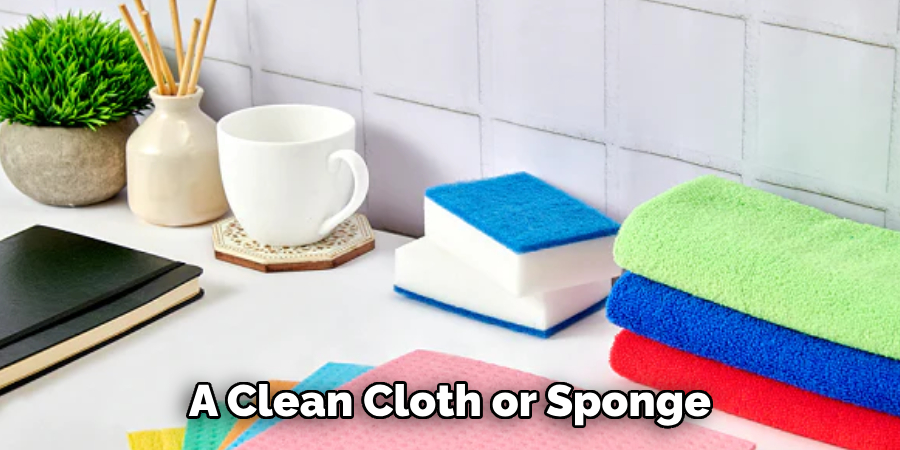
B. Inspecting Sink Surface for Damage or Discoloration and Addressing Promptly if Necessary
Once the sink is clean and dry, inspect the surface thoroughly. Look for any signs of damage, such as scratches or discoloration, that may have occurred during the cleaning process. If any damage is detected, address it promptly. Minor scratches can often be buffed out with a non-abrasive compound, while discoloration may require a specialized cleaning product designed for your sink’s material.
C. Maintaining Regular Cleaning Routine to Prevent Future Paint Stains and Keep Sink Looking Its Best
Establish a regular cleaning routine to prevent future paint stains and maintain the aesthetic of your sink. Use mild cleaning solutions and soft cleaning tools to avoid damaging the surface. Additionally, immediately clean up any spills, especially from substances known to stain, to prevent them from setting.
By following these post-removal care steps, you can ensure your sink remains clean, undamaged, and looking its best, effectively extending its lifespan and maintaining its functionality and appearance.
Preventive Measures
Taking preventive measures is crucial in maintaining your sink’s pristine condition and avoiding the inconvenience of removing paint stains. These steps not only safeguard your sink’s physical appearance but also contribute to a safer and more efficient painting environment.
A. Using Drop Cloths or Plastic Sheeting to Protect Sink During Painting Projects
Before beginning any painting project, it is advisable to cover your sink and adjacent areas with drop cloths or plastic sheeting. This simple precaution can save significant time and effort by preventing paint splatters and spills from reaching the sink surface in the first place. Ensure the protective cover is securely in place to avoid slippage, which could expose the sink to potential stains.
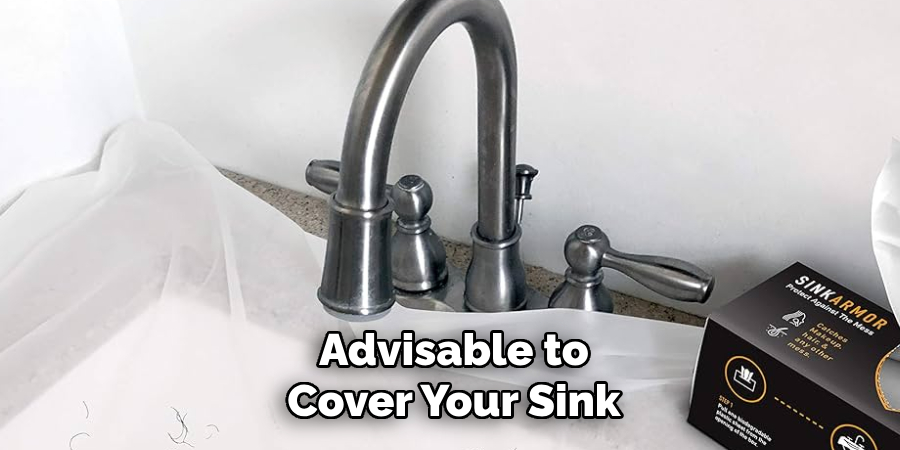
B. Ensuring Proper Ventilation and Air Circulation to Minimize Paint Fumes and Drying Time
A well-ventilated workspace is essential not only for the health and safety of the individuals involved but also for facilitating faster drying times of paint, reducing the likelihood of accidental smudges or spills. Open windows, use fans or rely on air purifiers to maintain adequate airflow throughout the painting project. This practice minimizes the concentration of paint fumes, promoting a healthier environment and preventing lingering odors or fumes from settling on surfaces, including the sink.
C. Educating Household Members on Proper Paint Handling and Cleanup Procedures to Prevent Stains
Knowledge is a powerful tool in preventing paint stains. Educating all household members, especially those who may engage in painting projects, on the importance of proper paint handling and cleanup procedures can significantly reduce the risk of paint-related accidents.
Establish guidelines for immediate cleanup of spills and proper storage of painting supplies. Encourage the use of painter’s tape around the sink area as an additional barrier to keep paint where it belongs – on the brush or in the can, not on your sink.
By implementing these preventive measures, you can keep your sink looking new and avoid the time-consuming process of stain removal. It’s about creating a proactive approach to care and maintenance that preserves the beauty and functionality of your sink for years to come.
Final Thoughts
In summary, removing paint stains from sinks requires a blend of effective techniques, thoughtful preparation, patience, and diligent maintenance. Key methods for tackling these stubborn stains include the use of mild abrasives like baking soda and vinegar applications for a more natural approach and, when necessary, resorting to commercial paint stain removers designed for tougher jobs. Paramount to this process is the initial step of choosing the least invasive cleaning method to minimize potential damage to the sink surface.
The importance of preparation cannot be overstated. Protecting the sink area with drop cloths or plastic sheeting during paint projects and ensuring proper ventilation help prevent stains. Additionally, educating all household members on appropriate paint handling and cleanup procedures can significantly reduce the likelihood of accidental spills.
After stain removal, post-care steps such as a thorough cleaning of the sink surface, inspection for any cleaning-induced damage, and regular maintenance routines are crucial for preserving the sink’s aesthetics and functionality. Adhering to these protocols ensures not only the successful removal of paint stains but also the longevity and pristine condition of your sink.
The guide provided herein underscores the criticality of prompt action and the adoption of safe practices in the quest for how to get paint out of sinks. Waiting too long to address paint stains can allow the stain to set, making removal far more challenging and risking permanent damage to your sink. Utilizing the methods described, from simple household remedies to more specialized cleaners, equips you with the tools necessary to tackle this issue effectively.
Safety, too, cannot be overstressed. The chemicals and methods employed in stain removal come with their risks, necessitating careful handling and adherence to safety guidelines to protect both the individual performing the cleaning and the sink itself.
We encourage readers to apply the strategies delineated in this guide for both successful stain removal and prevention. Remember, the key to maintaining your sink’s pristine condition lies not only in knowing how to get paint out of sinks but also in taking preventive measures to ensure those stains never occur in the first place. Your sink is an integral part of your home; treat it with care, and it will serve you well for many years to come.

